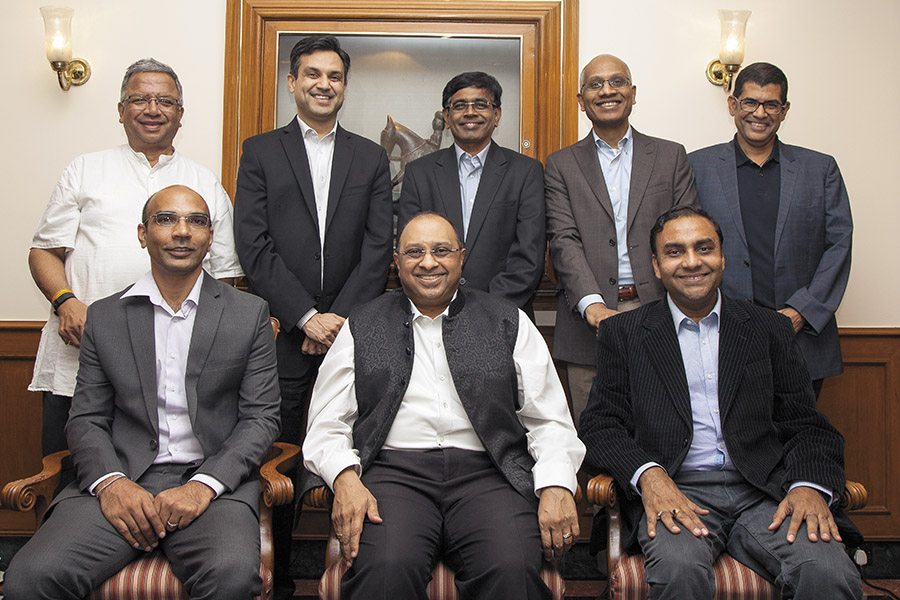
Going digital can help businesses in crises
Technology enables customisation of solutions for customers, drives deeper brand building, say top entrepreneurs

Image: Sri Manikandan for Forbes India
It is known that strategic digital transformation can help businesses connect better with customers. But the Bengaluru edition of Forbes India LeaderSpeak—The Digital Transformation Series revealed that the digital route could help businesses tide over crises as well.
Speaking at the fourth installment of the nationwide roundtable series, organised by Forbes India in association with Microsoft, Samit Ghosh, managing director and CEO of Ujjivan Financial Services, narrated how his company used technology to survive the headwinds faced by India’s microfinance industry.
In 2010, a spate of suicides in Andhra Pradesh had shed light on coercive tactics allegedly employed by microfinance institutions (MFIs) to recover dues, forcing the Reserve Bank of India (RBI) to issue a set of guidelines to regulate the industry that aims to serve the poor and the unbanked.
Among others, the RBI prescribed a 10 percent margin cap on large MFIs like Ujjivan.
While the company was not singed much due to its “good risk management system”, said Ghosh, the new guidelines made it difficult to do business.
“When the RBI came out with this regulation, our operating expenses ratio was 17 percent. So you can imagine the kind of trouble we were in,” Ghosh said. “So we started looking at ways to make our processes more efficient. We moved towards paperless transactions and credit processing. Our entire collection process was moved to an Android-based program and we developed programs for credit evaluation on tablets.”
These digital initiatives helped Ujjivan bring down its operating costs to 7 percent of its turnover from 17 percent earlier and, Ghosh forecasts, the number may go down to 5 percent.
Listen to the customer
Ghosh further said that as Ujjivan moves towards becoming a bank (it secured a small bank licence from the RBI last November), it is mandated to use technology to differentiate itself and make itself viable. The Bengaluru-based financial services institution conducted extensive research among its clients to understand what they like and dislike about bank transactions. “They didn’t like signing endless reams of paper and activation of the account after 24 hours,” Ghosh said. “They wanted all the services at their doorsteps—be it opening an account or subsequent transactions. So we have developed a mobile bank based on a tablet.”
Listening to potential customers and customising solutions for them can be a big differentiator that can help businesses do well, agrees Rostow Ravanan, CEO and managing director of IT firm Mindtree. “To roll out an end-user advantage is a big differentiator in today’s world,” he said. He also cited the example of India’s biometric-based unique identification programme, Aadhaar, which is helping citizens reap benefits ranging from easily applying for passports to opening bank accounts. “The extent to which products and services of all kinds can be personalised today wasn’t possible earlier when current technology in the form of devices and platforms like the cloud weren’t there,” Ravanan said.
Arjun Singh, managing director of Yodlee Infotech, a financial data platform that enables companies to develop financial applications and solutions, said that billions of dollars were being spent on big data not to make new discoveries, but to make “better, hyper-personalised offerings to consumers to attract them towards one product versus another”.
Supply chain efficiency
Technology isn’t the premise of new-age companies alone. Even so-called traditional companies can leverage digital tools and techniques to stay relevant. A classic example is jewellery firm C Krishniah Chetty and Sons.
The business that was founded in 1869 in Bengaluru is using digital tools to give itself the modern edge. This includes the use of 3D printing to make customised pieces of jewellery, a time-consuming process earlier.
The use of technology spills over to other critical functions as well. C Vinod Hayagriv, managing director of C Krishniah Chetty and Sons, said, “Over four to five generations of transformations, our back-end functions are fairly well structured. We use digital techniques to track material flow and split them into smaller batches. For instance, diamonds worth 1,000 carats can be packed into batches of 3 carats, 5 carats, 10 carats and so on; and every small movement in the supply chain can be tracked.”
The human factor
The challenge with the rapid and ever-evolving advent of technology is the swift re-skilling of people that needs to take place but isn’t happening at the desired pace, says Priyanshu Singh, managing director, Adecco India, the domestic arm of the global human resource solutions firm. “We are adding about a million people to the workforce almost every month. My guess is that 80 percent of them aren’t readily employable,” said Singh. “Technologies are evolving but we aren’t being able to rescale and re-employ our people, and as technology makes them more redundant not everyone will get absorbed in the new order of things. That is a big challenge.”
Old professions, new vocations
The need to re-skill India’s workforce is evident from the fact that a number of existing professions are undergoing a paradigm shift. Advertising, for instance.
While the traditional means of print, outdoor and broadcast advertising are still relevant, they are being challenged by online and digital advertising.
According to Amit Gupta, co-founder of InMobi Technology Services, a mobile advertising firm, the digital and online ad industry is worth $100 billion globally and mobile advertising accounts for around half of this.
“This $100 billion will become $200 billion in the next two to four years and the underlying reason is changing media consumption patterns,” said Gupta.
He said that a lot of discussions are taking place that indicate that digital marketing should be the mainstream medium for all chief marketing officers (CMO) to focus on. “The CMO has to be an excellent data analyst now,” Gupta said.
(This story appears in the 03 February, 2017 issue of Forbes India. To visit our Archives, click here.)
Post Your Comment














